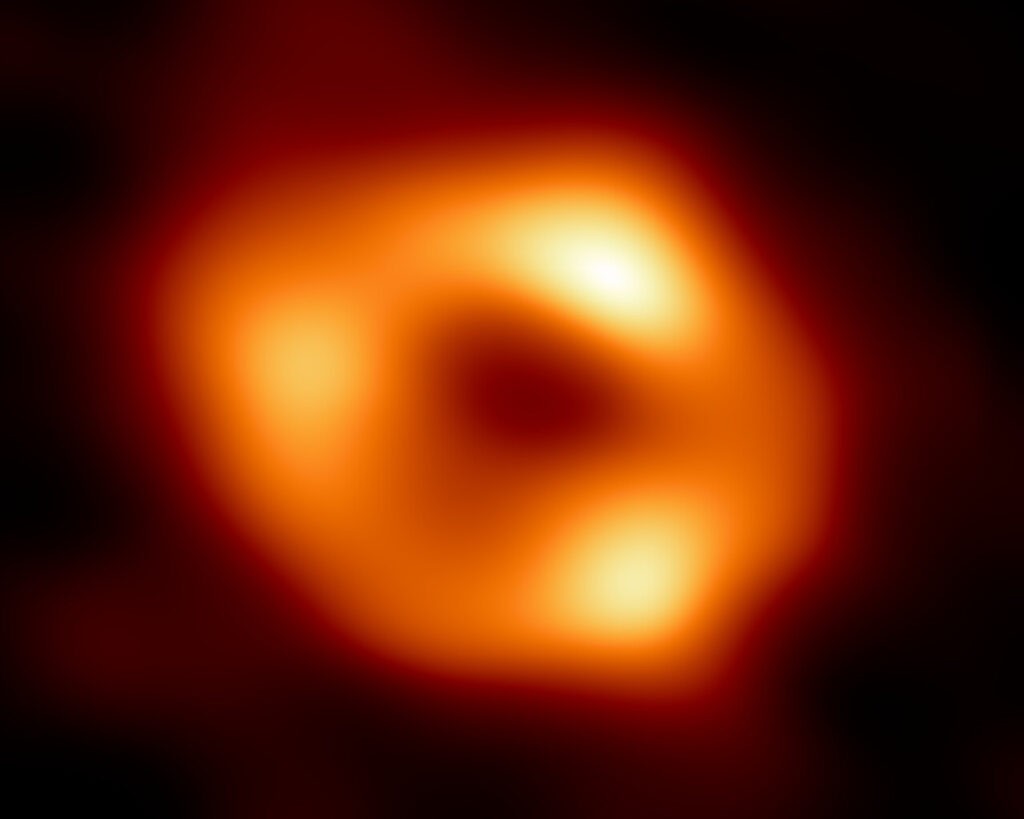On a dark summer night, when one gazes towards the sky, a hazy band of white light is visible. This band constitutes most of our galaxy, the Milky Way, visible from Earth’s perspective. Within the band and the constellation Sagittarius, lies a supermassive object, whose presence was revealed by decades of studies of observations of stars orbiting around a dark patch.
These observations helped in calculating the mass of that object – 4 million times the mass of our Sun. Accordingly, it was classified as a supermassive black hole, named Sagittarius A* (Sgr A*, pronounced “sadge-ay-star”).

First image of the black hole at the center of the Milky Way

This is the first-ever image of Sgr A* and the first direct evidence of its presence in the heart of our galaxy. This image shows a dark central region (called a shadow) surrounded by a bright ring-like structure. Light from the gas swirling around the black hole appears as a bright ring, and anything including light that eventually crosses its event horizon, gets swallowed by the black hole, leaving behind no trace at all, just a dark void in the center.
Just three years ago, in April 2019, we witnessed one of the significant breakthroughs in astronomy – the first image of a black hole. Messier 87 is a supergiant elliptical galaxy, 55 million light-years away from Earth in the constellation Virgo (1 light-year equals 9,500,000,000,000 or 9.5 trillion km). At the center of this galaxy lies a monstrous black hole, M87*.
This black hole is 1500 times more massive than Sgr A*, but is also 2000 times farther away from us. Sgr A* is only 27,000 light-years away from Earth. Because of this proportion, the two black holes appear very similar to us when we look at them in the sky.

Einstein’s Theory of Relativity
The astronomical community has monitored the motion of stars around the heart of our galaxy for decades. With careful analysis of the orbit of those stars, the mass of Sgr A* has been calculated with extreme precision. It allowed scientists and researchers to predict the size of the black hole shadow very accurately (in accordance with Einstein’s theory of relativity).



A daunting challenge – Size of the telescope
Because of the massive distance of black holes from Earth, any physical telescope should be of the size of Earth, which is impossible. To overcome this challenge, scientists came up with the idea of creating a powerful Event Horizon Telescope, linking together eight radio observatories spread across the Earth to form a single “Earth-sized” virtual telescope. The telescope gets its name after the event horizon, the boundary of the black hole beyond which nothing can escape.

The telescopes highlighted in yellow were part of the EHT network during the observations of Sagittarius A* in 2017. These include the Atacama Large Millimeter/submillimeter Array (ALMA), the Atacama Pathfinder EXperiment (APEX), IRAM 30-meter telescope, James Clark Maxwell Telescope (JCMT), Large Millimeter Telescope (LMT), Submillimeter Array (SMA), Submillimetere Telescope (SMT) and South Pole Telescope (SPT).
Highlighted in blue are the three telescopes added to the EHT Collaboration after 2018: the Greenland Telescope, the NOrthern Extended Millimeter Array (NOEMA) in France, and the UArizona ARO 12-meter Telescope at Kitt Peak.
The Very Long Baseline Interferometry (VLBI) is a network of radio antennas that combine to create an equivalent of a telescope with a diameter like Earth’s. In interferometry, each radio telescope is at a different location. By correlating their signals and analyzing the collected data, the source’s image can be reconstructed.

These radio telescopes work in pairs contributing a piece of information to the entire image. Telescopes that are distant can detect the smallest and sharpest features of the image, while those that are closer detect the broader features. Orientation also plays an important part as every possible angle picks up a different part of the black hole.
Capturing and making a perfect image would need telescopes of all different separations and orientations. EHT’s eight telescopes scattered around the planet capture only some part of the image. Fortunately, as the Earth rotates, the projected separations and orientations between the telescopes change, providing a bit more of the information required to make a perfect image.
Another challenge – Turbulent surrounding of Sgr A*
The hot gas spiraling around both the black holes moves at roughly the same speed. While it takes days to weeks to orbit the much larger M87*, the time needed by the gas to make an orbit around Sgr A* is much lesser, in minutes. This means as the data was being collected during the Earth’s rotation, the material around Sgr A* was swirling so quickly that its appearance kept on changing every minute.
How was the image of Sgr A* captured finally?
To capture the range of appearances of Sgr A*, the imaging team produced thousands of images with different methods, thereby filling in the blanks to the complete information. Every image is slightly different but consistent with the EHT data. By averaging these images, the team was able to highlight the common features that appeared in most of the images and a bright ring clearly emerges.

It is noteworthy that not all of the images were similar. In fact, the team found out that they can cluster the images into four categories based on similar visual characteristics. Three of the clusters had a ring-like feature differing only in the brightness around the ring. However, there existed a smaller fourth cluster that contained images that did not seem ring-like.

As a part of scientific analysis, the fourth cluster could not be fully ruled out. But through the algorithms and years of exhaustive tests on both real and simulated data, the team is confident that there is compelling evidence of a ring-like structure. A detailed analysis of the images unveiled that they all share the same ring size, in perfect agreement with earlier observations and theory.
What lies ahead?
One of the big goals for the scientists going forward is to not just see a still image of the black hole but actually see it evolving as the gas slowly fall in towards the event horizon.
Even though we have analyzed different scales of mass – all the way from stellar-mass black holes to supermassive black holes, we don’t see a crack in the theory. Further research in black hole physics will help in pushing the limits of how we can test our theory of gravity which we really expect to break down somewhere along the way.
And at that point in time, we might have an understanding of a completely unique set of physical laws, which, at the current moment, we can’t even comprehend. The future is inspiring, and these discoveries put us much closer to the exhilarating times ahead.


Hi there mates, its an impressive article and fully explained, keep it up all the time.